Author Archive
Thursday, November 20th, 2008
One of the world’s preeminent jazz venues, the Village Vanguard has presented nearly all of the greatest musicians in jazz since 1957. Renowned for its rich history and great acoustics, over 100 commercial albums have been recorded within the triangle-shaped basement room in New York’s Greenwich Village.
Live At The Village Vanguard is a collaboration between WBGO and NPR Music presenting live broadcasts from the legendary club, both on air and streaming online. WBGO’s Josh Jackson hosts all the concerts; you can also read his take on the events on WBGO’s live blog and join the discussion in a chat room. After each show is over, NPR Music will host the archived recordings of all the concerts.
Posted in Music News | 6 Comments »
Tuesday, November 18th, 2008
DURHAM, N.C – WNCU 90.7 FM will sponsor a two hour radio program on the campus of North Carolina Central University in the B.N. Duke Auditorium on Friday, December 5th at 8pm. This inaugural holiday jazz remote broadcast will be aired live.
The North Carolina Central University Jazz Studies Department, featuring faculty and students under the direction of Dr. Ira Wiggins, will provide the entertainment and WNCU jazz announcer, Ken Grady, will be the Emcee.
Everyone is invited to attend this free, informal event. Come out and help create a live audience ambience for this broadcast. Parking for this event is free and is located adjacent to the auditorium.
Lackisha Sykes, WNCU-FM Acting General Manager, states “We are excited about this wonderful collaboration with the Jazz Studies Department and are asking all to come out and support public radio and keep jazz alive.”
Newly appointed Program Director, BH Hudson, adds “This is only the beginning of our efforts to expand the possibilities for the jazz community.”
Additionally, WNCU will provide an all dessert reception in the atrium beginning at 7pm in honor of all WNCU members.
Not a member yet? It’s not too late to join. Secure your tax deductible membership before 7pm on December 5th and join us for holiday desserts.
Posted in Music News | 5 Comments »
Tuesday, November 4th, 2008
Joseph Arthur Chambers was born June 25, 1942 in Stoneacre, Virginia. Chambers studied music theory at the Philadelphia Conservatory and the American University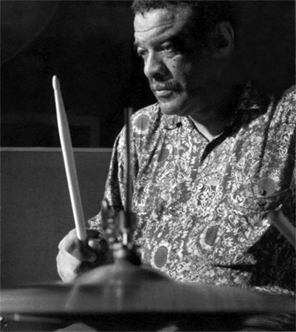 in Washington while drumming with the JFK Quintet. In 1964 he moved to New York to play with Eric Dolphy, Freddie Hubbard and Andrew Hill, doyens of the Blue Note Records label, while also attending Hall Overton’s composition classes. Chambers shone on vibist Bobby Hutcherson’s records as both drummer and composer, contributing the title tracks to Dialogue and Oblique and a masterful, side long suite to Components that pursued Hall Overton’s Third Stream inclinations between Thelonious Monk and Igor Stravinsky. Since the early 70s he has also appeared with and composed for Max Roach’s percussion ensemble M’Boom. In 1974 his “The Almoravid” was played at Carnegie Hall. In the late 90s he produced some fine contemporary work with Mulgrew Miller and Eddie Henderson. This ferociously accurate drummer is equally adept on vibraphone, with a feel both for swing and space, his compositional imagination informs every nuance of his art. in Washington while drumming with the JFK Quintet. In 1964 he moved to New York to play with Eric Dolphy, Freddie Hubbard and Andrew Hill, doyens of the Blue Note Records label, while also attending Hall Overton’s composition classes. Chambers shone on vibist Bobby Hutcherson’s records as both drummer and composer, contributing the title tracks to Dialogue and Oblique and a masterful, side long suite to Components that pursued Hall Overton’s Third Stream inclinations between Thelonious Monk and Igor Stravinsky. Since the early 70s he has also appeared with and composed for Max Roach’s percussion ensemble M’Boom. In 1974 his “The Almoravid” was played at Carnegie Hall. In the late 90s he produced some fine contemporary work with Mulgrew Miller and Eddie Henderson. This ferociously accurate drummer is equally adept on vibraphone, with a feel both for swing and space, his compositional imagination informs every nuance of his art.
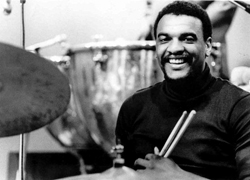 Joe Chambers is an extremely versatile and tasteful master of all post-bop idioms. Chambers drives an ensemble with a light hand; his time is excellent and his grasp of dynamics superb. He’s not a flashy drummer by any means, but he’s a generous collaborator who makes any group of which he’s a part as good as it can possibly be. Chambers worked around Washington, D.C., in his late teens. After moving to New York in 1963, he played with Eric Dolphy, Freddie Hubbard, Jimmy Giuffre, and Andrew Hill. In the mid-’60s, Chambers played with a number of the more progressively inclined musicians associated with the Blue Note label, such as vibist Bobby Hutcherson and saxophonists Joe Henderson, Wayne Shorter, and Sam Rivers. In 1970, Chambers joined Max Roach’s percussion ensemble, M’Boom, as an original member. During the ’70s, Chambers played with a great many of jazz’s most prominent elder statesmen, including Sonny Rollins, Tommy Flanagan, Charles Mingus, and Art Farmer. With Flanagan and bassist Reggie Workman, Chambers formed the Super Jazz Trio. Joe Chambers is an extremely versatile and tasteful master of all post-bop idioms. Chambers drives an ensemble with a light hand; his time is excellent and his grasp of dynamics superb. He’s not a flashy drummer by any means, but he’s a generous collaborator who makes any group of which he’s a part as good as it can possibly be. Chambers worked around Washington, D.C., in his late teens. After moving to New York in 1963, he played with Eric Dolphy, Freddie Hubbard, Jimmy Giuffre, and Andrew Hill. In the mid-’60s, Chambers played with a number of the more progressively inclined musicians associated with the Blue Note label, such as vibist Bobby Hutcherson and saxophonists Joe Henderson, Wayne Shorter, and Sam Rivers. In 1970, Chambers joined Max Roach’s percussion ensemble, M’Boom, as an original member. During the ’70s, Chambers played with a great many of jazz’s most prominent elder statesmen, including Sonny Rollins, Tommy Flanagan, Charles Mingus, and Art Farmer. With Flanagan and bassist Reggie Workman, Chambers formed the Super Jazz Trio.
In the late ’70s, he co-led a band with organist Larry Young. Chambers recorded with bands led by trumpeter Chet Baker and percussionist Ray Mantilla in the early ’80s. He’s maintained his association with Roach into the ’90s. Chambers has recorded infrequently as a leader; his output as a sideman, however, continues to be sizable. At age 63, Joe Chambers ranks as one of the most notable drummers and percussionists of his generation, and a staple of the venerable (and once-independent) Blue Note label. Not only have his highly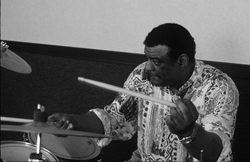 imaginative compositions been covered by the likes of Freddie Hubbard and Bobby Hutcherson (with whom he’s also performed), but he has gone on to write the scores for several Spike Lee films, including She’s Gotta Have It (1986) and Mo’ Better Blues (1990). Chambers has continued to tour and record over the years, blending various rhythms and sonic textures into his music, which is not limited to just jazz. Instead he brings in inspiration from the sounds he grew up around in Philadelphia, including R&B, gospel, and rock, mixing them in with his conservatory-trained technique. imaginative compositions been covered by the likes of Freddie Hubbard and Bobby Hutcherson (with whom he’s also performed), but he has gone on to write the scores for several Spike Lee films, including She’s Gotta Have It (1986) and Mo’ Better Blues (1990). Chambers has continued to tour and record over the years, blending various rhythms and sonic textures into his music, which is not limited to just jazz. Instead he brings in inspiration from the sounds he grew up around in Philadelphia, including R&B, gospel, and rock, mixing them in with his conservatory-trained technique.
his eclectic approach is telling on his new release, The Outlaw (Savant), in which he presents original material and new arrangements of a handful of covers (including Duke Ellington’s “In A Sentimental Mood”), stepping away from the drum kit to concentrate — for the first time in his career — on the vibraphone and other instruments. The CD cycles seamlessly through modern jazz, samba, soft, synth-laden melodies, and even Afro-Cuban sounds, revisiting the past but also keeping a keen eye on what lies ahead.
Posted in Artist of the Month | 5 Comments »
Wednesday, October 22nd, 2008
“This Is How We Do It”
North Carolina Central University’s Homecoming events begin on Saturday, October 25, 2008, and end on Sunday, November 2, 2008. The week is full of activities that are open to the public. To download the pdf of the schedule, click here. To learn more about the events or to purchases tickets, visit https://www.nccu.edu/Alumni/homecoming/index.cfm.
Saturday, October 25, 2008
Eagle Jam Concert
Featuring: Ludacris & Lloyd
McDougald-McLendon Gymnasium-7:00 PM
Sunday, October 26, 2008
Miss NCCU Coronation
Semi-Formal Attire is Required
B.N. Duke Auditorium-5:00 PM
Monday, October 27, 2008
Choir Ball
B.N. Duke Auditorium-6:00 PM
Choir Ball
B.N. Duke Auditorium-9:00 PM
Tuesday, October 28, 2008
Lyceum Program
Featuring: Gospel Artist, Byron Cage
McDougald-McLendon Gymnasium-8:00 PM
Wednesday, October 29, 2008
SGA Fashion Show
McDougald-McLendon Gymnasium-7:00 PM
Thursday, October 30, 2008
Homecoming Comedy Show
Featuring: Ronnie Jordan, Arnez J and Tony Roberts
McDougald-McLendon Gymnasium-8:00 PM
Friday, October 31, 2008
Society of Golden Eagles Induction
McDougald-McLendon Gymnasium-9:00 AM
Society of Golden Eagles Luncheon
Sheraton Imperial Hotel-12:00 PM
Homecoming Golf Tournament
The Crossings Golf Club – 1:00 PM
Class Reunion Registration
Class Headquarter Hotel-2:00 PM
Mock Funeral
James E. Shepard Library-2:00 PM
All-Class Reunion Reception
Sheraton Imperial Hotel-6:00 PM
Pan-Hellenic Step Show
McDougald-McLendon Gymnasium-7:00 PM
Classes of the 80s and 90s Cabaret
This is not an NCCU sponsored event.
8:00 PM
Will Downing Concert & Gerald Albright Concert
This is not an NCCU sponsored event.
Carolina Theater – 9:00 PM
Alumni Party
Sheraton Imperial Hotel-10:00 PM
Saturday, November 1, 2008
Alumni/Student Breakfast Reception
Alfonso Elder Student Union-8:00 AM
Homecoming Parade on Fayetteville Street
9:00 AM
Homecoming Game
NCCU vs. Edward Waters
O’Kelly-Riddick Stadium-1:00 PM
Pre-Dawn Dance
McDougald-McLendon Gymnasium-Gymnasium 8:00 PM
Alumni Dance
Sheraton Imperial Hotel-9:00 PM
Sunday, November 2, 2008
Gospel Concert
B.N. Duke Auditorium-4:00 PM
Posted in Public Affairs | Comments Off on North Carolina Central University Homecoming 2008
Tuesday, October 21st, 2008
DURHAM, NC – Triangle residents facing foreclosure should mark their calendars to attend a workshop and listen to a radio broadcast designed to help them save their homes. In response to the national home foreclosure crisis, WNCU 90.7 FM and the City of Durham’s Department of Neighborhood Improvement Services and Community Development are conducting the second workshop in the “Saving Our Dream” series on Saturday, October 25, 2008 at the H.M. Michaux, Jr. School of Education Building on the campus of North Carolina Central University. This event is free and open to the public but persons interested in attending should call to reserve a seat at 919-682-5788 or 1-877-684-2778.
Seminars begin at 9:00 a.m. and will cover information about early intervention for homeowners whose mortgages are 30 to 90 days delinquent, foreclosure prevention for homeowners with mortgages 90 days delinquent, and a session with local tax specialists. Certified housing counselors, loan servicers, tax specialists, investors, realtors, and a bankruptcy attorney will also be on site for one-on-one assistance. Other community partners for the seminars include Neighborhood Pride Alliance and the Durham Regional Community Group.
At 11:00 a.m., WNCU 90.7 FM will also broadcast a live town hall meeting entitled “Avoiding Foreclosure: Intervention and Prevention”, to encourage listeners facing foreclosure to seek assistance early. Listeners are invited to listen in on-air or attend the meeting at the H.M. Michaux, Jr. School of Education Building as a part of our audience and participate in a discussion about the national home foreclosure crisis that is affecting our local area. Peter Skillern, Executive Director of the Community Reinvestment Association of North Carolina, will moderate the panel. Panelists will include Jill Fuller, Mortgage Loss Mitigation Manager, Sun Trust Mortgage; Glyndola Beasley, Executive Director, Durham Regional Community Development Group; Wendell Bullard, President, North Carolina Association of Realtors; Kimberly Simpson, Tax Administrator, Durham County Tax Office; and homeowner Tony Garrett.
For additional information, contact WNCU 90.7 FM at (919) 530-7833.
Posted in Public Affairs | 2 Comments »
Wednesday, October 1st, 2008
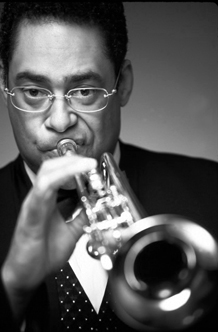 Born in Oakland, CA, on July 24, 1953, Jon Faddis began playing trumpet at age eight, inspired by an appearance of Louis Armstrong on “The Ed Sullivan Show.” Three years later, his trumpet teacher Bill Catalano, an alumnus of the Stan Kenton band, turned the jazz- struck youngster on to Dizzy Gillespie. By his mid-teens, Jon had not only met Dizzy, he’d even sat in with his hero’s combo at the famed Jazz Workshop in San Francisco. Born in Oakland, CA, on July 24, 1953, Jon Faddis began playing trumpet at age eight, inspired by an appearance of Louis Armstrong on “The Ed Sullivan Show.” Three years later, his trumpet teacher Bill Catalano, an alumnus of the Stan Kenton band, turned the jazz- struck youngster on to Dizzy Gillespie. By his mid-teens, Jon had not only met Dizzy, he’d even sat in with his hero’s combo at the famed Jazz Workshop in San Francisco.
Upon graduating high school in 1971, Jon joined Lionel Hampton’s band as a featured soloist and moved to New York. That same year, responding to an invitation from Mel Lewis to drop by the Village Vanguard whenever he got to New York, Jon sat in with the Thad Jones/Mel Lewis Big Band on one of their regular Monday night sessions. That sit-in turned into four years of Monday nights playing with the band, as well as a tour of the Soviet Union with the highly acclaimed unit. Jan also toured with Charles Mingus and recorded on the Pablo label with Dizzy and Oscar Peterson.
Other highlights included filling in (at age of 18) for an ailing Roy Eldridge in an all-star concert led by Charles Mingus at New York’s Philharmonic Hall; a Carnegie Hall gig with Sarah Vaughan; two years in attendance at the Dick Gibson~s Annual Colorado Jazz Party where he was featured in a historic duet with Eubie Blake; performances with Gil Evans’ and Count Basie’s big bands; appearances at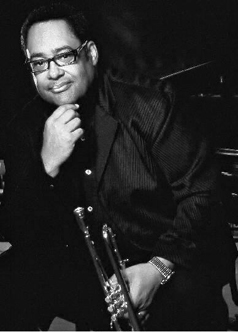 Radio City Music Hall and festivals here and abroad; and sitting in with Dizzy whenever possible. Radio City Music Hall and festivals here and abroad; and sitting in with Dizzy whenever possible.
However, those studio years ultimately proved significant in his artistic development. Exposure to a diverse spectrum of music helped shape him into the broad-based interpreter and (creator in) African-American idioms that he is today. Jon’s distinctive trumpet voice would be heard on albums by performers as disparate as Duke Ellington, the Rolling Stones, Frank Sinatra, Kool and the Gang, Luther Vandross, Quincy Jones, Billy Joel and Stanley Clarke, to name a few. His horn was heard on the theme of “The Cosby Show,” on the soundtrack of Clint Eastwood’s films “The Gauntlet” and “Bird,” and on many commercials. Jon Faddis had become one of the most in-demand session musicians in New York.
A turning point was the invitation from Dizzy to accompany him on a visit to the White House in 1982. The occasion was an “In Performance” ceremony in which Dizzy and several other major American artists showcased young colleagues they believed to be “on the verge of exceptional careers.” Jon’s participation in the event was apparently enough to convince him he had a lot more to offer than horn section lead on jingles, or the occasional solo on a lavish studio production of a pop star.
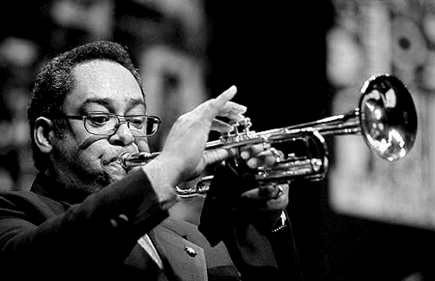 Within a year, he left studio life and was out on the club scene with a working group that included saxophonist Greg Osby and pianist James Williams. In 1987, Jon played the major role in organizing and rehearsing Dizzy’s big band, the one that would celebrate the legendary bebopper’s 70th birthday on tour here and abroad. Jon was a featured soloist and later assumed the same position as musical director of Dizzy’s United Nation Orchestra, another international touring all-star group formed in 1989. Within a year, he left studio life and was out on the club scene with a working group that included saxophonist Greg Osby and pianist James Williams. In 1987, Jon played the major role in organizing and rehearsing Dizzy’s big band, the one that would celebrate the legendary bebopper’s 70th birthday on tour here and abroad. Jon was a featured soloist and later assumed the same position as musical director of Dizzy’s United Nation Orchestra, another international touring all-star group formed in 1989.
Faddis served as musical director for the Carnegie Hall Centennial Jazz Band, which paved the way to an ongoing gig with the world- renown music hall. He is the musical director of the Carnegie Hall Jazz Band, an 18-piece all-star orchestra which serves as a vehicle for some of the greatest names in jazz to present concerts that are not part of their regular repertoire. Praised for its swinging sound and tight ensemble work, the Band has paid tributes to Miles Davis, Erroll Garner, Benny Goodman and Tito Puente.
Frequently tapped for his conducting prowess, Faddis is also music director of the 1995 Lincoln Center Jazz Orchestra “The Majesty of Louis Armstrong Tour” and the “Newport Jazz Festival 40th Anniversary Tour.”
Posted in Artist of the Month | 12 Comments »
Wednesday, September 10th, 2008
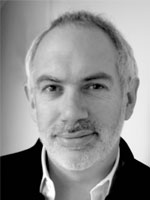 By Robin Pogrebin By Robin Pogrebin
In 2006 Jazz at Lincoln Center turned to Adrian Ellis for help.
The organization had been struggling under the weight of its explosive growth since moving into a new $131 million home in the Time Warner Center at Columbus Circle in 2004. It had tripled its budget and taken on three stages, where before it didn’t have even one.
Mr. Ellis, a management consultant who has specialized in advising nonprofit cultural institutions, said it was like giving the organization a Lamborghini, without first making sure anyone knew how to drive.
Now Mr. Ellis is at the wheel.
As Jazz at Lincoln Center prepares to open its fifth and biggest season at the Time Warner building on Sept. 18, Mr. Ellis is completing his first year as its executive director, the sixth person in that post in six years.
It would seem that the hardest work is past. Jazz at Lincoln Center has paid off the construction costs on its new building and audiences have grown accustomed to visiting its three spaces: the 1,200-seat Rose Theater, the smaller Allen Room overlooking twinkling Central Park South and the intimate Dizzy¹s Club Coca-Cola. (The organization used to borrow space at LincolnCenter.)
But there are still challenges. The Allen Room and Rose Theater devote less than a quarter of their schedules to jazz. They are rented out the rest of the time because Jazz at Lincoln Center needs the income. Mr. Ellis said he planned to double that percentage of jazz over the next five years.
He also plans to invigorate the public areas separating the three theaters, which, because Jazz at Lincoln Center ran out of money during construction, have had a lifeless, utilitarian air. Mr. Ellis said he plans to add a cafe, an improved gift shop and an information center for jazz events all over the city. And he wants to schedule free live music during the day.
His most important task, however, will be building the organization’s endowment, which currently stands at $11 million. Mr. Ellis said the organization would try to raise $70 million over the next five years.
“Jazz at Lincoln Center needs to be able to weather hard times,” he said. He added that he had seen many artistically strong but financially weak arts organizations unable to focus on their mission “because they are worried about meeting next month’s payroll.”
Mr. Ellis said he also wants to commission, record and broadcast “more jazz than we do” and to make the organization’s extensive recordings, charts and lectures accessible online.
The 2008-9 season will feature more than 3,000 events, including education activities, touring, performances and sets at Dizzy’s Club Coca-Cola.
Highlights include the pianist Ahmad Jamal performing with his trio and the Jazz at Lincoln Center Orchestra; a festival in honor of Thelonious Monk; a two-night stand by Eddie Palmieri’s Latin-jazz big band; and a concert honoring the 50th anniversaries of two landmark albums, John Coltrane’s “Giant Steps” and Miles Davis’s “Kind of Blue,” led by the organization’s longtime artistic director, Wynton Marsalis.
Mr. Marsalis makes the artistic and programming decisions for Jazz at Lincoln Center and is very much its public face. Bruce MacCombie, a previous executive director, said: “If the expectation is that one¹s going to have much or anything to do with the creative side of things, one shouldn’¹t have that illusion. It’s obviously Wynton’s show.”
But Rob Gibson, the organization’s first executive director, said Mr. Marsalis stayed on his side of the aisle. “He’s a terrific trumpet player, a great educator, a wonderful composer, and he did a great job leading the band,” Mr. Gibson said. “But I always told him, ŒStay out of the administration,’ and he did.”
Mr. Ellis and Mr. Marsalis say they have a good working relationship, with Mr. Ellis primarily responsible for operational and financial matters and Mr. Marsalis handling the artistic side. “It’s exactly like our music, there are no stars,” Mr. Marsalis said. “It’s clear who does what. We made a commitment to each other to work together.”
They also share a passion for jazz. “He loves the music,” Mr. Marsalis said.
Mr. Ellis has had ample preparation for his new job. Before starting AEA Consulting in 1990, he earned degrees from University College Oxford and the London School of Economics, worked as a civil servant in the Treasury and the Cabinet Office in London and managed the establishment of the Design Museum, which opened on Butler’s Wharf in London in 1989.
At AEA, which continues to operate out of offices in New York and London, Mr. Ellis advised cultural institutions like the J. Paul Getty Museum in Los Angeles, the San Francisco Opera, the Isabella Stewart Gardner Museum in Boston and the National Gallery in London. He became something of a specialist in counseling nonprofit organizations on the perils of managing growth.
In March 2006 he was retained to develop a strategic plan for Jazz at Lincoln Center. A year and half later he was brought on board to implement it. “He’s the right person in the right job at the right time,” said Gordon J. Davis, the founding chairman of Jazz at Lincoln Center.
The executive director’s position has been a revolving door. Mr. Ellis replaced Katherine Brown, who stepped down in June 2007 after a little more than a year in the job, though she had spent a decade with the organization.
Her predecessor, Derek E. Gordon, also spent just a year in the position.
“The job kept growing and changing as we went along,” said Lisa Schiff, the chairwoman of the board of Jazz at Lincoln Center. “Nobody has quite had the birthing pains we had.”
“We had to learn how to run this organization without letting it run us,” she said. “We went from running some concerts to running a major arts facility. Pretty scary stuff.”
Increasingly Jazz at Lincoln Center seems to be on solid footing. The average performance capacity was 92 percent in fiscal year 2008, up from 86 percent in 2006. Ticket revenue increased 13 percent over that period. The annual budget has reached $42 million, up from less than $1 million when Jazz at Lincoln Center was founded 22 years ago.
Mr. Ellis said a central part of his mandate was creating future audiences for jazz. Thus the educational programming ranges from WeBop! classes for preschoolers to a middle school jazz academy to a high school jazz band program to Swing University, which offers adults the opportunity to learn from jazz scholars, historians and musicians.
“The central purpose of Jazz at Lincoln Center is to help ensure the vitality of the music in the long term,” Mr. Ellis said. “We’ve built a sense of organizational and financial stability upon which we can grow.”
Posted in Music News | 4 Comments »
Wednesday, September 3rd, 2008
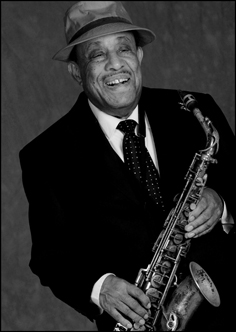 Lou Donaldson, alto saxophonist, recording star and entertainer extraordinaire was born in Badin, North Carolina on November 1, 1926. He is the child of parents, Lucy Wallace Donaldson, mother, and Louis Andrew Donaldson, Sr., father. His mother was a first grade teacher at Badin High School, Musical Director at the school, and a concert pianist who was a graduate of Cheney University. His father was a graduate of Livingstone College, an AME Zion minister, and insurance agent. Lou is the second of 4 children, between older sister Margaret and younger sister Elizabeth and brother William, all of whom ended up involved with music. Lou never studied piano because his mother had a switch that she would crack across the fingers when students missed a note. That turned him completely away from being a pianist. When he was about 9 years old, she heard him singing or humming and she took him aside and told him that he had more musical talent than anyone in the family and that he needed to play some type of instrument. She got a clarinet from the Band Director, Leo Gabriel, at the Alcoa Aluminum Plant Band. Although she knew nothing about the clarinet, she taught him basic music and they used the clarinet book to learn the fingerings and how to play the clarinet. Lou mastered the instrument and this ignited his pursuit of a career in music. Lou Donaldson, alto saxophonist, recording star and entertainer extraordinaire was born in Badin, North Carolina on November 1, 1926. He is the child of parents, Lucy Wallace Donaldson, mother, and Louis Andrew Donaldson, Sr., father. His mother was a first grade teacher at Badin High School, Musical Director at the school, and a concert pianist who was a graduate of Cheney University. His father was a graduate of Livingstone College, an AME Zion minister, and insurance agent. Lou is the second of 4 children, between older sister Margaret and younger sister Elizabeth and brother William, all of whom ended up involved with music. Lou never studied piano because his mother had a switch that she would crack across the fingers when students missed a note. That turned him completely away from being a pianist. When he was about 9 years old, she heard him singing or humming and she took him aside and told him that he had more musical talent than anyone in the family and that he needed to play some type of instrument. She got a clarinet from the Band Director, Leo Gabriel, at the Alcoa Aluminum Plant Band. Although she knew nothing about the clarinet, she taught him basic music and they used the clarinet book to learn the fingerings and how to play the clarinet. Lou mastered the instrument and this ignited his pursuit of a career in music.
At age 15, Lou matriculated to North Carolina A& T College where he received a Bachelor’s of Science degree and joined the marching band playing clarinet. After being drafted into the US Navy in 1945, he played in the Great Lakes Navy Band where, when playing for dances, he would also play the alto saxophone. After going into Chicago several times, he heard of Charlie Parker and he decided that this was the style of playing he would make his own. Returning from the military back to North Carolina A& T College, he played in the dance band led by Billy Tolles, who was a great saxophonist who played with several groups.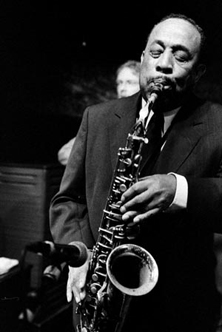
Lou went to New York in 1950. Being a GI and a Veteran he enrolled in the Darrow Institute of Music, which was a GI school, and was paid a monthly stipend so that he could survive. While at the school, he played many small clubs in Harlem where he lived at 127th Street and 8th Avenue with his new wife, Maker. Maker was his longtime sweetheart from North Carolina and remained his wife and business partner for 56 years until her death in 2006. Together they raised two children — Lydia, deceased, who was a nurse and educational recruiter, and Dr. E. Carol Webster, clinical psychologist and author who resides in Fort Lauderdale and who, along with husband Charles, founded the African American Success Foundation that Lou very happily supports each year by doing a Jazz Benefit.
Once he moved to New York, Lou worked weekends in Jersey with Dud Bascomb’s band. One night while working at Minton’s Playhouse — the famous jazz club, he was approached by Alfred Lyons of Blue Note Records to make a recording and he suggested that Lou make a Charlie Parker-type recording which he did with the Milt Jackson Quartet. At that time, it was Milt Jackson, Percy Heath, John Lewis, and Kenny Clark. Later on this group would be called the Modern Jazz Quartet. The record was successful and the company asked him to make a record on his own and this is why he’s most proud of his time at Blue Note Records– because this date started a career for him that actually made him bring several musicians to Blue Note Records.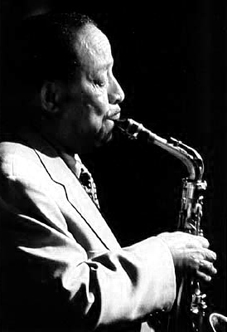
In the mid 60’s, Lou furthered his success as a musician and businessman. He set up his own tour of clubs — which was no easy feat in those days. Beginning in Rochester, NY, then to Buffalo, NY, and on to Pittsburgh, Pa. — where he worked two great clubs.
During these memorable years, Lou had four distinct groups that he would use for the organ sound: one group was John Patton on organ, Bill Hardman on trumpet, Grant Green on guitar, and Ben Dixon on drums. Another group was Lonnie Smith on organ, Billy Kaye on drums, Mark Elf on guitar — and sometimes Melvin Sparks on guitar, and Joe Dukes on drums — the greatest organ drummer of all times. Later he had another group with Caesar Frazier on organ, Eric Johnson on guitar, and Billy Kaye on drums with Sweet Lou on alto. Another of Lou’s groups had Charles Earland on organ, Jimmy Ponder on guitar, Blue Mitchell on trumpet, and Idris Muhammad on drums. These groups played mostly the so-called “ghetto clubs” where the fans really got into their music and sometimes they were booked even for dancing. It was a very successful set up and several other people like Hank Crawford, Jack McDuff, Groove Holmes, Sonny Stitt, and even Dizzy found out about these clubs and had a good run following this idea. Later in the ‘80’s,
Lou was awarded the honorary Doctorate of Letters by North Carolina A& T University and a scholarship was established in his name that is awarded to the most gifted jazz musician at North Carolina A&T University each year. He was inducted into the International Jazz Hall of Fame and is the recipient of countless other honors and awards for his outstanding contributions to jazz.
Posted in Artist of the Month | 8 Comments »
Sunday, August 24th, 2008
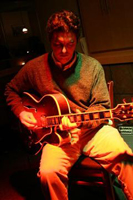 RAIN DATE: SEPTEMBER 4, 2008 RAIN DATE: SEPTEMBER 4, 2008
On September 4, 2008, around 10 a.m., anyone within range of NCCU’s bowl area will hear the sounds of cool mainstream jazz wafting through the air as WNCU 90.7 FM presents “Jazz in the Bowl.” WNCU’s morning announcer, B.H. Hudson, will bring the music and her laid back style to the yard to welcome students, faculty and staff back to campus for the beginning of another academic year.
“We have fun with the music here at WNCU and we want everyone in the NCCU community to hear what we do and be excited by it,” said Hudson. “We want them to know Duke Ellington, Artie Shaw, Tommy Dorsey, Ella Fitzgerald, Sarah Vaughn and other jazz greats past and present. And most of all we want them to know that they don’t have to go far to listen to the greats. WNCU is located in the Farrison Newton Communications building on campus”.
Jazz guitarist Kevin Van Sant will perform live at this event. He is a jazz guitarist based in Durham, NC. Van Sant regularly performs across North Carolina and elsewhere on the East Coast. He has also performed in Russia and throughout Europe. Performances in Europe include five times at the legendary Montreux Jazz Festival in Switzerland.
WNCU general manager, Edith Thorpe, hopes “Jazz in the Bowl” will entice faculty, staff, and new student listeners to WNCU.
“One of our primary commitments at WNCU is to make sure that our students are aware of mainstream jazz in its many forms,” said Thorpe. “With this event, we hope to further demonstrate our pledge to make sure that jazz is alive and well in this community. What better way to do this than to expose our young people to this extraordinary music. Jazz doesn’t have a hip hop beat, it swings. We want to be a conduit to help NCCU students explore this music.”
WNCU 90.7 FM is a National Public Radio affiliate station and functions as a training facility for student interns. WNCU is one of only a few jazz stations in the country to play mainstream jazz as a primary format.
“Jazz in the Bowl” is free and open to the public. This event will air live on WNCU 90.7 FM from 10 a.m. until 11:45 p.m. Thursday, August 28, 2008. For additional information call 919-530-7445.
Posted in Uncategorized | 9 Comments »
Friday, August 15th, 2008
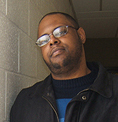 DURHAM, N.C. – WNCU 90.7 FM and North Carolina Central University’s Alumni Affairs office have developed a new partnership to connect with NCCU graduates. Saturdays at 10:30 a.m. WNCU airs NCCU Alumni Today on 90.7FM in the Triangle and www.wncu.org on the web. The show offers graduates information about what’s happening on campus and in the lives of their fellow Eagles. Truitt O’neal hosts the show. He is a 2001 graduate of NCCU with his bachelor’s degree in English and a concentration in electronic media. He is the former general manager of AudioNet, NCCU’s student radio station. He also worked as a student staff member for WNCU. Currently, O’neal is the news and public affairs director for WNNL The Light 103.9 FM and the Raleigh affiliate producer of the Yolanda Adams Morning Show. DURHAM, N.C. – WNCU 90.7 FM and North Carolina Central University’s Alumni Affairs office have developed a new partnership to connect with NCCU graduates. Saturdays at 10:30 a.m. WNCU airs NCCU Alumni Today on 90.7FM in the Triangle and www.wncu.org on the web. The show offers graduates information about what’s happening on campus and in the lives of their fellow Eagles. Truitt O’neal hosts the show. He is a 2001 graduate of NCCU with his bachelor’s degree in English and a concentration in electronic media. He is the former general manager of AudioNet, NCCU’s student radio station. He also worked as a student staff member for WNCU. Currently, O’neal is the news and public affairs director for WNNL The Light 103.9 FM and the Raleigh affiliate producer of the Yolanda Adams Morning Show.
“I am enthusiastic about returning to WNCU to produce NCCU Alumni Today,” said O’neal. “Over the upcoming weeks I look forward to talking with NCCU alumni from all walks of life across the country and around the world.”
Norma Petway, a 1977 graduate of NCCU and director of Alumni Relations, says the mission of NCCU Alumni Today as an extension of the mission of her office. According to Petway, the show “will update graduates on activities at NCCU and give information on how they can participate in university activities and contribute financially. The goal is to encourage every graduate to become an active Eagle.”
Since its debut in August 1995, WNCU, 90.7 FM, licensed to North Carolina Central University, has consistently fulfilled its mission to provide quality, culturally-appropriate programming to public radio listeners in the Triangle area. The format of this listener supported public radio station entertains the jazz aficionado, educates the novice jazz listener and disseminates news and information relative to the community-at-large. WNCU 90.7 FM is a 50,000 watt public radio station and an affiliate of NPR, PRI and Pacifica Radio.
Posted in Public Affairs | 6 Comments »
|


 in Washington while drumming with the JFK Quintet. In 1964 he moved to New York to play with Eric Dolphy, Freddie Hubbard and Andrew Hill, doyens of the Blue Note Records label, while also attending Hall Overton’s composition classes. Chambers shone on vibist Bobby Hutcherson’s records as both drummer and composer, contributing the title tracks to Dialogue and Oblique and a masterful, side long suite to Components that pursued Hall Overton’s Third Stream inclinations between Thelonious Monk and Igor Stravinsky. Since the early 70s he has also appeared with and composed for Max Roach’s percussion ensemble M’Boom. In 1974 his “The Almoravid” was played at Carnegie Hall. In the late 90s he produced some fine contemporary work with Mulgrew Miller and Eddie Henderson. This ferociously accurate drummer is equally adept on vibraphone, with a feel both for swing and space, his compositional imagination informs every nuance of his art.
in Washington while drumming with the JFK Quintet. In 1964 he moved to New York to play with Eric Dolphy, Freddie Hubbard and Andrew Hill, doyens of the Blue Note Records label, while also attending Hall Overton’s composition classes. Chambers shone on vibist Bobby Hutcherson’s records as both drummer and composer, contributing the title tracks to Dialogue and Oblique and a masterful, side long suite to Components that pursued Hall Overton’s Third Stream inclinations between Thelonious Monk and Igor Stravinsky. Since the early 70s he has also appeared with and composed for Max Roach’s percussion ensemble M’Boom. In 1974 his “The Almoravid” was played at Carnegie Hall. In the late 90s he produced some fine contemporary work with Mulgrew Miller and Eddie Henderson. This ferociously accurate drummer is equally adept on vibraphone, with a feel both for swing and space, his compositional imagination informs every nuance of his art. Joe Chambers is an extremely versatile and tasteful master of all post-bop idioms. Chambers drives an ensemble with a light hand; his time is excellent and his grasp of dynamics superb. He’s not a flashy drummer by any means, but he’s a generous collaborator who makes any group of which he’s a part as good as it can possibly be. Chambers worked around Washington, D.C., in his late teens. After moving to New York in 1963, he played with Eric Dolphy, Freddie Hubbard, Jimmy Giuffre, and Andrew Hill. In the mid-’60s, Chambers played with a number of the more progressively inclined musicians associated with the Blue Note label, such as vibist Bobby Hutcherson and saxophonists Joe Henderson, Wayne Shorter, and Sam Rivers. In 1970, Chambers joined Max Roach’s percussion ensemble, M’Boom, as an original member. During the ’70s, Chambers played with a great many of jazz’s most prominent elder statesmen, including Sonny Rollins, Tommy Flanagan, Charles Mingus, and Art Farmer. With Flanagan and bassist Reggie Workman, Chambers formed the Super Jazz Trio.
Joe Chambers is an extremely versatile and tasteful master of all post-bop idioms. Chambers drives an ensemble with a light hand; his time is excellent and his grasp of dynamics superb. He’s not a flashy drummer by any means, but he’s a generous collaborator who makes any group of which he’s a part as good as it can possibly be. Chambers worked around Washington, D.C., in his late teens. After moving to New York in 1963, he played with Eric Dolphy, Freddie Hubbard, Jimmy Giuffre, and Andrew Hill. In the mid-’60s, Chambers played with a number of the more progressively inclined musicians associated with the Blue Note label, such as vibist Bobby Hutcherson and saxophonists Joe Henderson, Wayne Shorter, and Sam Rivers. In 1970, Chambers joined Max Roach’s percussion ensemble, M’Boom, as an original member. During the ’70s, Chambers played with a great many of jazz’s most prominent elder statesmen, including Sonny Rollins, Tommy Flanagan, Charles Mingus, and Art Farmer. With Flanagan and bassist Reggie Workman, Chambers formed the Super Jazz Trio. imaginative compositions been covered by the likes of Freddie Hubbard and Bobby Hutcherson (with whom he’s also performed), but he has gone on to write the scores for several Spike Lee films, including She’s Gotta Have It (1986) and Mo’ Better Blues (1990). Chambers has continued to tour and record over the years, blending various rhythms and sonic textures into his music, which is not limited to just jazz. Instead he brings in inspiration from the sounds he grew up around in Philadelphia, including R&B, gospel, and rock, mixing them in with his conservatory-trained technique.
imaginative compositions been covered by the likes of Freddie Hubbard and Bobby Hutcherson (with whom he’s also performed), but he has gone on to write the scores for several Spike Lee films, including She’s Gotta Have It (1986) and Mo’ Better Blues (1990). Chambers has continued to tour and record over the years, blending various rhythms and sonic textures into his music, which is not limited to just jazz. Instead he brings in inspiration from the sounds he grew up around in Philadelphia, including R&B, gospel, and rock, mixing them in with his conservatory-trained technique. Born in Oakland, CA, on July 24, 1953, Jon Faddis began playing trumpet at age eight, inspired by an appearance of Louis Armstrong on “The Ed Sullivan Show.” Three years later, his trumpet teacher Bill Catalano, an alumnus of the Stan Kenton band, turned the jazz- struck youngster on to Dizzy Gillespie. By his mid-teens, Jon had not only met Dizzy, he’d even sat in with his hero’s combo at the famed Jazz Workshop in San Francisco.
Born in Oakland, CA, on July 24, 1953, Jon Faddis began playing trumpet at age eight, inspired by an appearance of Louis Armstrong on “The Ed Sullivan Show.” Three years later, his trumpet teacher Bill Catalano, an alumnus of the Stan Kenton band, turned the jazz- struck youngster on to Dizzy Gillespie. By his mid-teens, Jon had not only met Dizzy, he’d even sat in with his hero’s combo at the famed Jazz Workshop in San Francisco. Radio City Music Hall and festivals here and abroad; and sitting in with Dizzy whenever possible.
Radio City Music Hall and festivals here and abroad; and sitting in with Dizzy whenever possible. Within a year, he left studio life and was out on the club scene with a working group that included saxophonist Greg Osby and pianist James Williams. In 1987, Jon played the major role in organizing and rehearsing Dizzy’s big band, the one that would celebrate the legendary bebopper’s 70th birthday on tour here and abroad. Jon was a featured soloist and later assumed the same position as musical director of Dizzy’s United Nation Orchestra, another international touring all-star group formed in 1989.
Within a year, he left studio life and was out on the club scene with a working group that included saxophonist Greg Osby and pianist James Williams. In 1987, Jon played the major role in organizing and rehearsing Dizzy’s big band, the one that would celebrate the legendary bebopper’s 70th birthday on tour here and abroad. Jon was a featured soloist and later assumed the same position as musical director of Dizzy’s United Nation Orchestra, another international touring all-star group formed in 1989. By Robin Pogrebin
By Robin Pogrebin Lou Donaldson, alto saxophonist, recording star and entertainer extraordinaire was born in Badin, North Carolina on November 1, 1926. He is the child of parents, Lucy Wallace Donaldson, mother, and Louis Andrew Donaldson, Sr., father. His mother was a first grade teacher at Badin High School, Musical Director at the school, and a concert pianist who was a graduate of Cheney University. His father was a graduate of Livingstone College, an AME Zion minister, and insurance agent. Lou is the second of 4 children, between older sister Margaret and younger sister Elizabeth and brother William, all of whom ended up involved with music. Lou never studied piano because his mother had a switch that she would crack across the fingers when students missed a note. That turned him completely away from being a pianist. When he was about 9 years old, she heard him singing or humming and she took him aside and told him that he had more musical talent than anyone in the family and that he needed to play some type of instrument. She got a clarinet from the Band Director, Leo Gabriel, at the Alcoa Aluminum Plant Band. Although she knew nothing about the clarinet, she taught him basic music and they used the clarinet book to learn the fingerings and how to play the clarinet. Lou mastered the instrument and this ignited his pursuit of a career in music.
Lou Donaldson, alto saxophonist, recording star and entertainer extraordinaire was born in Badin, North Carolina on November 1, 1926. He is the child of parents, Lucy Wallace Donaldson, mother, and Louis Andrew Donaldson, Sr., father. His mother was a first grade teacher at Badin High School, Musical Director at the school, and a concert pianist who was a graduate of Cheney University. His father was a graduate of Livingstone College, an AME Zion minister, and insurance agent. Lou is the second of 4 children, between older sister Margaret and younger sister Elizabeth and brother William, all of whom ended up involved with music. Lou never studied piano because his mother had a switch that she would crack across the fingers when students missed a note. That turned him completely away from being a pianist. When he was about 9 years old, she heard him singing or humming and she took him aside and told him that he had more musical talent than anyone in the family and that he needed to play some type of instrument. She got a clarinet from the Band Director, Leo Gabriel, at the Alcoa Aluminum Plant Band. Although she knew nothing about the clarinet, she taught him basic music and they used the clarinet book to learn the fingerings and how to play the clarinet. Lou mastered the instrument and this ignited his pursuit of a career in music.

 RAIN DATE: SEPTEMBER 4, 2008
RAIN DATE: SEPTEMBER 4, 2008 DURHAM, N.C. – WNCU 90.7 FM and North Carolina Central University’s Alumni Affairs office have developed a new partnership to connect with NCCU graduates. Saturdays at 10:30 a.m. WNCU airs NCCU Alumni Today on 90.7FM in the Triangle and www.wncu.org on the web. The show offers graduates information about what’s happening on campus and in the lives of their fellow Eagles. Truitt O’neal hosts the show. He is a 2001 graduate of NCCU with his bachelor’s degree in English and a concentration in electronic media. He is the former general manager of AudioNet, NCCU’s student radio station. He also worked as a student staff member for WNCU. Currently, O’neal is the news and public affairs director for WNNL The Light 103.9 FM and the Raleigh affiliate producer of the Yolanda Adams Morning Show.
DURHAM, N.C. – WNCU 90.7 FM and North Carolina Central University’s Alumni Affairs office have developed a new partnership to connect with NCCU graduates. Saturdays at 10:30 a.m. WNCU airs NCCU Alumni Today on 90.7FM in the Triangle and www.wncu.org on the web. The show offers graduates information about what’s happening on campus and in the lives of their fellow Eagles. Truitt O’neal hosts the show. He is a 2001 graduate of NCCU with his bachelor’s degree in English and a concentration in electronic media. He is the former general manager of AudioNet, NCCU’s student radio station. He also worked as a student staff member for WNCU. Currently, O’neal is the news and public affairs director for WNNL The Light 103.9 FM and the Raleigh affiliate producer of the Yolanda Adams Morning Show.